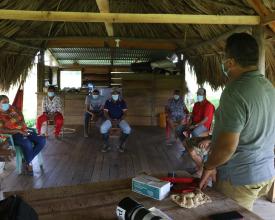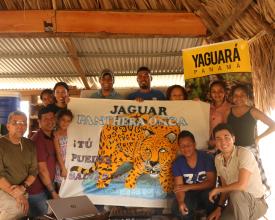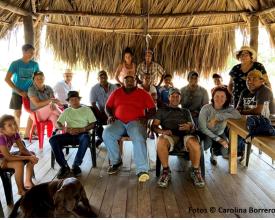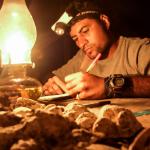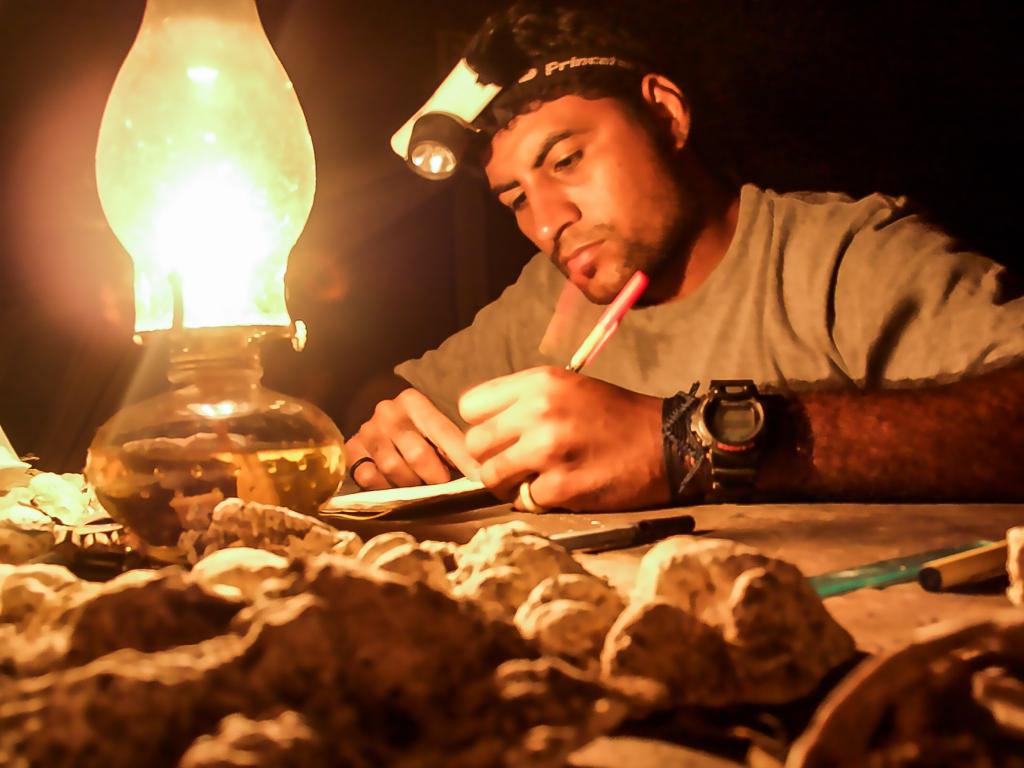
Solutions for human-jaguar coexistence through improvements in livestock farms and the use of technology in communities adjacent to the Alto Darién Protected Forest.
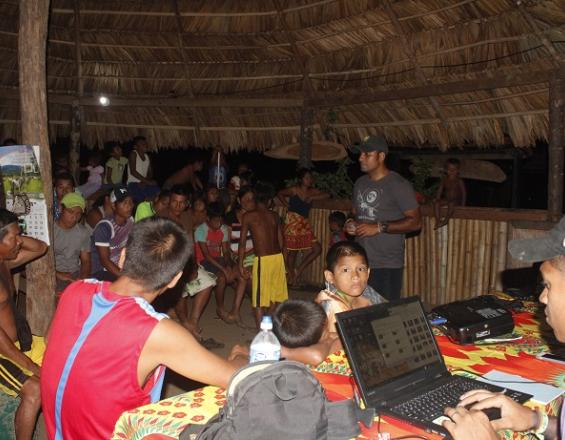
The project aims to minimize the human-jaguar conflict by implementing farm management plans with anti-predation measures, GPS telemetry to understand jaguar behavior and we work with the community. Most jaguar deaths are due to predation on livestock that is not properly managed. We support producers to maximize the benefits on the farm. The plans reorganize the property and the producers work intensively, using less paddock area, and these with water, improved pasture, cultivation areas, night pens for cows and calves to spend the night, all of this encourages the paddock areas to regenerate and transform into forest. The measures we have used are electric fences powered by a solar panel, collars with bells for the cattle and with small lights on the sides of the collar. We have placed collars on jaguars to understand their movement on 14 farms. Extensive cattle ranching has diminished biodiversity in Panama.
Context
Challenges addressed
One of the biggest challenges is to ensure that the 14 farms in the Agua Buena community have management plans and anti-predation measures in place (so far there are 6 farms with measures in place). Having these farms in a cluster makes the site a model at the national and regional level. Jaguars have large home ranges and monitoring more individuals with GPS collars will help to better understand the dynamics at these sites and thus the measures applied will be more accurate. Getting the farms to become more intensive, so that some of the paddocks regenerate to forest again. More talks and training workshops will help more people understand how important it is to conserve biodiversity. To achieve that the national authorities understand that it is important to use the models established here so that in the places where there are conflicts between humans and jaguars, they support the application and implementation for the well being of all and biodiversity.
Location
Process
Summary of the process
The building blocks are intertwined and interact in parallel in search of solutions. We must approach the communities so that they understand what the project is about, so we create trust and they know what it is all about. As they are cattle farms, we explain how to reorganize them with management plans; it is a tool for them to improve their production systems and if there is jaguar depredation, they learn about practices that minimize the conflict. As the farms have forest remnants, this is where the jaguars move and if the cattle are not well cared for there will be high economic losses. In these forests we place cameras to know how many jaguars there are and the biodiversity that exists, in addition to placing GPS collars on the jaguars to have information on how many farms they can travel through. The monitoring generates information that supports the management of the site and by socializing the results with the owners they understand why it is important to work in an orderly manner on the farm, and why it is important to maintain biodiversity. The communication of the results is essential so that there is a process of change in people's attitudes to improve. Positive progress is made if there are alliances that contribute to improvement in all senses.
Building Blocks
Outreach with communities in the Agua Buena area of Chucunaque
The first thing we did was to talk to two teachers who own a cattle ranch in Agua Buena de Chucunaque, they are leaders. They told us the history of the site, so that we could understand the dynamics of the area and see if what is happening there has the same pattern as in other places with conflict. Then they supported us in making the call. It is easier to attract people through someone the community respects. On the 14 kilometers of road we always take the windows of the car down and greet people and if they need a ride to the entrance or to the farm we do it, because this creates bonds and trust, because it allows us to talk more with them. The teachers and we went house to house to tell the people at the meeting about the jaguars and other activities. The talk is presented, we give a space for each one of them to express themselves about how they perceive the jaguar and what has been happening in the area, and how they think they could minimize the conflict. After the community has expressed itself, we explain to them what we can do together, then we carry out the training and create stronger links and trust with the communities. Trust is the key to making the project work and it is a step-by-step process.
Enabling factors
- Create alliances with families and communities,
- Advise them to improve their activities,
- Maintain constant communication with different members of the community, although there may be a few who lead the process within the community,
- Always listen to what they think, besides being respectful of their opinions that, if they are biased by culture and myths, little by little, based on trust, they will understand and change their attitude.
Lesson learned
Working with the communities is fundamental, the constancy of our work has borne fruit. We have sought tools that can be understandable and replicable for the community and at the same time is useful for other communities.
Working together helps to get more support (such as the Pathfinder Award). Several members of the community are now multiplier agents and guide their neighbors and other communities. Others have become environmental promoters for jaguar conservation. The community now has scientific information and has learned to manage their activities on the farms.
In Panama they talk about "the tiger kills people", referring to the jaguar. It is a complicated issue in rural areas. It is mentioned in the meetings, trying to make people realize that in Panama no one has been killed by a jaguar. Now they know that we have to respect them and that it is vital for our forests. As I mentioned before, for the project to work in the medium and long term there must be trust between Yaguará and the communities.
Resources
Livestock farm management plans with anti-predation measures
In Panama, farms are culturally extensive and without good livestock practices. The management plans that Yaguará Panama seeks to support producers in having a better sustainable use of the land, under intensive management so that the paddocks are small (with more small keepers they walk less and feed better, without spending a lot of energy) and the animals are healthy and in better condition. In the case of cows with calves, a corral is prepared to reduce predation, since we know that the most vulnerable animals are the cows with calves.
Anti-predation measures include: electric fences powered by a solar panel, collars with bells for the cows as an auditory and luminous repellent because they have lights that are activated at night.
The plans have a map of current and future use so that the producer can appreciate the changes and is taught to keep track of what is happening on the farm, only in this way will he be able to see how the changes are occurring and at what point he begins to have a real gain in livestock production.
An important change is that now the paddocks have water for the animals to drink; usually they do not and when the cows go to the river they get stuck or are preyed upon by jaguars.
Enabling factors
The application of small intensive paddocks with improved pasture makes the animals healthier and stronger.
- healthier and stronger,
- when selling the cattle, they receive better economic income,
- they know when and which cows are pregnant, and this means that they do not lose animals to chicken,
- less predation by jaguars,
- less deaths of cows and calves due to clogging in the rivers because they have water in the paddocks. At this point there is confidence to continue working and the producers themselves show their neighbors how they have achieved this.
Lesson learned
The lessons learned have been many. The owners of farms in Agua Buena de Chucunaque have been able to see that by managing or moving the animals with small paddocks and having water tubs in them, with improved pasture and keeping records of what happens on the farm, the results are very good.
Now they know that they must see the farm as a small business, only in this way they will be able to see the results of the work they carry out and that it is a dignified work, that well carried out, the family can live much better.
In addition, with the farm management plan they can also opt for loans in the banks of Panama, because now in Panama if someone wants a bank loan for these activities, they require a farm management plan and since they already have it, it is easier for them, they just have to continue advising them.
In addition, they have also learned that it is better to get advice from people who know and this is something that Yaguará Panama will continue to contribute, since the presence of Yaguará Panama in the area will be for a long term.
Jaguar and biodiversity monitoring
One of the interesting aspects of this project is to measure the biodiversity in each of the farms and to know how many jaguars there are or cross the farms. For this we monitor them with camera traps. As each jaguar has unique spotting patterns for each individual, it is possible to know how many there are and record when they are in the different farms. In addition, we combine the camera traps with GPS collars that we place on the jaguars on the farms to know where they move, how many farms they visit and how much time they spend on the farm. This helps us understand the jaguar dynamics in an environment dominated by cattle ranchers and forest corridors between farms.
With the data from the camera traps and GPS collars we have been able to give the community a better understanding of the jaguar and why it is an important species for the ecosystems and for our own existence as human beings.
Based on the information collected we can measure indicators such as: number of jaguars per year and abundance of other mammals that are important prey for the jaguar, and we can help local and national decision makers and farm management decision makers.
Enabling factors
Through photos, footprints and tracking of jaguars we began to create empathy between the community and the animals that move within the farm.
This empathy generates that the people of the community are concerned about the safety of the jaguars they know.
We are conducting scientific research hand in hand with the people of the community. By knowing how many jaguars there are in the area, they have valuable information that can be used for community tourism.
Long-term monitoring is the best way to understand the jaguar and the dynamics of the community.
Lesson learned
We at Yaguará Panama always say that "the real and final destiny of conservation is in the hands of the people who live directly with nature". Projects should always be carried out with a high percentage of people from the communities where the project is carried out. If there is no continuity with funds to continue, it is likely that if there is a good foundation some of the community members will take the step to be better and have coexistence with nature.
Having photos gives a face and sometimes even a name to the animals and this generates a positive feeling to take care of the jaguar and the environment in general.
Always keep the community informed about the results of scientific studies in the area, this is fundamental.
And again, this interaction generates trust and if there is trust in these contexts, it is possible that they will continue with the agreement. Try as much as possible to keep the community always excited about what is being done, if you don't do this, they may lose follow up and disappear.
Communication at all levels
For the Yaguará Panama Foundation, communication is vital at all levels, even though we are a science-based organization. Science must be translated to the community and to other scientists, but also in media that have real impact with communities, decision makers, students of all levels and people from a child to a senior citizen. In order to reach everyone, we communicate in international impact magazines such as National Geographic, which is seen by millions of people around the world. This project is related to the topic of agriculture and since 2014 every month we publish in a national magazine called Ecos del Agro, which reaches more than 10,000 people. We also publish in the traditional written press several articles a year. We go on radio and TV about 10 to 20 times a year, in addition to our social networks. We give virtual talks (in pandemic: more than 11,000 people have listened to our presentations), and face-to-face, workshops. If we REALLY want to reach the majority of people we must communicate in all available media, because those who watch or see one, do not see others and so on.
Enabling factors
- More children know about the jaguar and biodiversity.
- More people of all levels and social classes are aware of what is happening in the country,
- More people are trained and empowered in biodiversity issues and jaguar and livestock farm improvements,
- More people are trained and empowered in biodiversity issues and improvements of cattle ranches and the jaguar, there is credibility on the part of decision-makers thanks to scientific monitoring.
- Communities living in wild and rural areas now know who to turn to if there is a conflict situation between humans and jaguars.
Lesson learned
The most important lesson learned from our whole process is that we have to work more with the communities and the rest of the people who live in the country, since everyone is important.
There are many people who live in the city and have farms in very remote areas and for this and other reasons it is very important to spread the word in the main cities and all the towns where possible.
The strategy is unique and is to reach the majority, or everyone if possible, although this implies a greater effort and work, but we know that the fruits will be seen in the medium or long term.
Strategic alliances with different partners
The regent in Ambiente is the Ministry of Environment and we have been working with them since 1998, but in 2017 we signed a cooperation agreement to minimize the jaguar-human conflict through a preventive management project to seek solutions. We have also achieved an alliance with USFWS to work farm management plans, anti-predation measures, monitoring with cameras and collars with the jaguar. We work with the Small Grants Program/UNDP/GEF and are working on a camera trap monitoring project in Darien and support/advice to community-based organizations, so that communities know how to solve and take to another level what is happening in their areas. Nat Geo supports us in the most extensive camera trap monitoring project in Panama in Darien, in addition to helping us in outreach and communications at the international level. With the Howard Huge Medical Institute (HHMI) we work in scientific research with camera traps, in addition to disseminating, communicating and educating through their digital platforms what we find in the Darien National Park. Other important alliances are the Ministry of Tourism, ANAGAN, ISA, University of Panama, UNEP. We work with some indigenous groups and more than 10 community-based organizations distributed throughout the country.
Enabling factors
Each and every one of the alliances are important, since some of them work on similar but not the same topics, and all of them are intertwined so that these projects are medium and long term, and those that involve the communities can be very long term projects, and we are talking about a minimum of 6 years. And for this to happen, the alliances with people, communities, decision makers and the executing agency, donors, there must be trust and be able to work as a team and we have achieved this with everyone. Never belittle a person who wants to help.
Lesson learned
Each and every one of the alliances are important, since some of them work on similar but not the same topics, and all of them are intertwined so that these projects are medium and long term, and those that involve the communities can be very long term projects, and we are talking about a minimum of 6 to 10 years of duration. And for this to happen, the alliances with the people, communities, decision-makers and executing agency, donors, must have trust and be able to work as a team, and we have achieved this with everyone. Never underestimate a person in the community who wants to help and always listen and then look for ways to move forward.
Impacts
The community of Agua Buena de Chucunaque in Darien is a model to follow throughout Panama:
- 14 farm-owning families have been trained and sensitized and 6 have management plans and anti-predation measures.
- The first community-based organization with objectives to minimize human-jaguar conflict in Panama.
- Since 2017 on the 14 farms no jaguar has been killed again.
- The management of livestock and agricultural areas has generated a peaceful coexistence and changes in attitudes towards the jaguar and biodiversity in general.
This change has generated results such as
- fewer losses due to depredation
- fewer losses due to water shortages in the watering holes (around 20 animals were reported dead in 2019),
- less death of calves by hen peccaries
- less predation by jaguars
- an increase in the weight of the animals and this translates into sale prices.
In addition, there is a process of change in the mentality of the people who are working with us and now other neighbors want to be part of the project. We have created a group of environmental promoters to support and raise awareness in the communities. We are also working with the Ministry of the Environment and the environmental police to deal with cases more quickly and effectively. We want to take this project model to other parts of the country because it generates positive changes for the communities and biodiversity.
Beneficiaries
The community of Agua Buena: 14 families, with 85 people, but in total there are 340 people. They will have increased productivity while at the same time conserving. We hope that these models will be applied at the national level for the good of all.
Sustainable Development Goals
Story
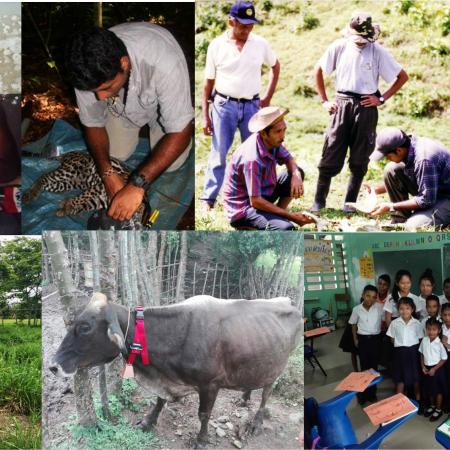
I am Ricardo Moreno, Panamanian biologist and since I was a child I wanted to do what I do, it is my life. In 2014, we started monitoring jaguars in Darien. A month later, I was informed that a female had been killed and I was able to see the skin in the house of the person who had killed her for preying on calves. I managed to take a picture of the skin and comparing the stains with the picture of "Eva" I realized that it was her. Once again I had to watch another jaguar being killed, it was frustrating and triggered me to work harder, but smarter. Moreno and colleagues in 2015 created Fundación Yaguará Panamá to achieve a greater impact at all levels. The information of 371 jaguars killed in Panama, generated an impact on the authorities and we managed to sign an agreement with the Ministry of Environment to minimize the human-jaguar conflict in 2017. We began the search for livestock farms with depredation to support in the preparation of management plans with anti-predation measures, and the first family that accepts is in Agua Buena de Chucunaque in Darien. We began to place cameras and these revealed 3 adult jaguars and one was a female with two cubs walking on the property. Thanks to the implementation of the first farms the other landowners started to get excited to see the results, which have been less loss due to drought, less predation on livestock, less death by chicken, increase in weight and others. On the first farm, a female jaguar was also captured and fitted with a GPS collar to track her behavior and how many farms she visited. The whole community began to appreciate "Chucunaque", the female with two cubs wearing the collar. Some owners confessed that they were going to kill her, but when they saw the collar they did not. Now we can see the fruits, there is less predation. Thanks to all this, a community-based organization called AMBICHU was created in Agua Buena, with the objective of minimizing the conflict and adapting the farms to have a better yield. Other communities in Darien and other parts of the country have been inspired by the model farms in Agua Buena to do the same. Yaguará wanted to reach more people and we created two groups of environmental promoters to disseminate and sensitize more people. In 2021 we see a new female and she has a cub, Chucunaque and two males. Many thought that it could not be done, but by communicating, working with a scientific basis and in conjunction with the community, we are achieving it.


